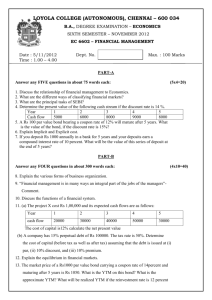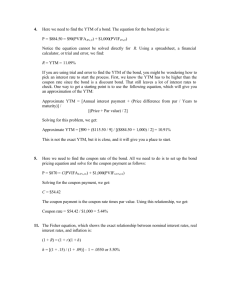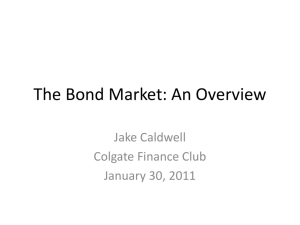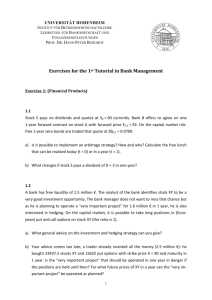Money Market and Debt Instruments
advertisement
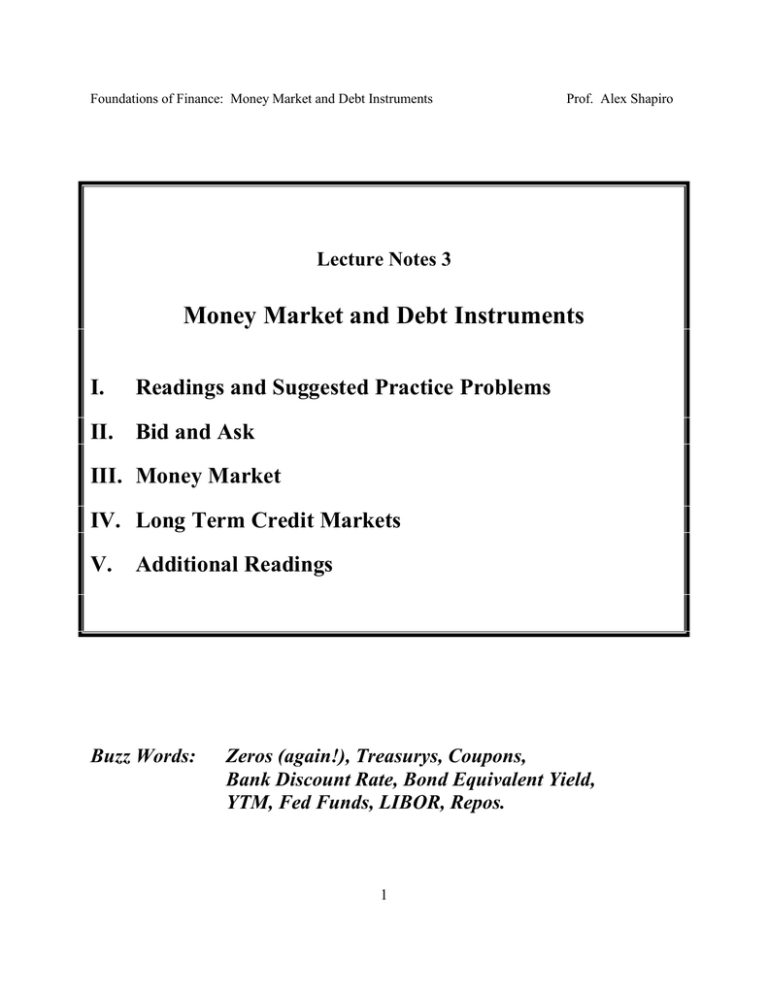
Foundations of Finance: Money Market and Debt Instruments Prof. Alex Shapiro Lecture Notes 3 Money Market and Debt Instruments I. Readings and Suggested Practice Problems II. Bid and Ask III. Money Market IV. Long Term Credit Markets V. Additional Readings Buzz Words: Zeros (again!), Treasurys, Coupons, Bank Discount Rate, Bond Equivalent Yield, YTM, Fed Funds, LIBOR, Repos. 1 Foundations of Finance: Money Market and Debt Instruments I. Readings and Suggested Practice Problems 1. 2. BKM, Chapter 2, Sections 2.1, 2.2. BKM, Chapter 14, Sections 14.1- 14.3. Suggested Problems, Chapter 2: 2-7, Chapter 14: 1, 2, 5. II. Bid and Ask Bid Price: Price at which an intermediary is ready to purchase the security. Price received by a seller. Asked Price: Price at which an intermediary is ready to sell the security. Price paid by a buyer. (Also called, “Ask” or “Offer” price). Spread: Difference between bid and asked prices (bid price is lower than the asked price, and the spread is the intermediary’s “profit”). Investor Price Intermediary Buy Asked/Ask/Offer Sell Sell Bid Buy 2 Foundations of Finance: Money Market and Debt Instruments III. Money Market Money market instruments are short-term debt instrument. That is, those are financial assets paying par value (face value) at maturity and typically having maturities of one year or less (and are usually zeros; no coupon payment before maturity). They are also typically safe and liquid. A. U.S. Treasury Bills These are obligations backed by the "full faith and credit" of the U.S. government. (Among all money market instruments, T-bills are regarded as safest with respect to default risk.) T-bills (and most money-market instruments) are discount instruments. They do not pay coupons, but instead are sold below (at discount from) their par (face) value. Maturities: Issued weekly with maturities of 4, 13, and 26 weeks. The Treasury Department sells T-bills (and other securities) at auctions held throughout the year (http://www.publicdebt.treas.gov/) 1. Bank Discount Rate. T-bills are quoted on a 360-day discount basis using the bank discount rate (a 360-day year is commonly used in pricing money market instruments). The bank discount rate is defined as: r BD = 360 Par - Price n Par So, n r BD Price = Par 1 − 360 where rBD is the quoted bank discount rate and n is the number of days from settlement to maturity. (The word "discount" is used in many different contexts in finance. rBD is not the interest rate used in a present value calculation.) 3 Foundations of Finance: Money Market and Debt Instruments TREASURY BONDS, NOTES & BILLS A WSJ clipping from 1/29 for 1/28 data See notes distributed in class 4 Foundations of Finance: Money Market and Debt Instruments Example See WSJ clipping for Treasury Bills (close of 1/28): Maturity Apr 29 Days to Mat Bid 90 4.38 Asked 4.37 Chg +0.02 Ask Yld. 4.48 Buying at the ask bank discount rate of 4.37% on Thursday 1/28, the trade settles on 1/29. Hence 90 days to maturity. The price paid (for $100 face value) is: Price = $100 (1 − 90 × 0.0437 / 360) = $98.9075 2. Bond-equivalent yield The bond equivalent yield is calculated as follows: r BEY = 365 Par − Pr ice n Pr ice Since there are 365 days in a year, the bond equivalent yield is an annual percentage rate (APR) with n-day compounding, where: M = 365/n, r1/M = (Par-Price)/Price. Note that (Par-Price)/Price is also the holding period return, and in this case it is also the Yield To Maturity (YTM). The quoted “Ask Yield” in the WSJ is the bond equivalent yield. It thus reports the YTM in an APR form. Example The bond equivalent yield for the Apr 29 T-bill purchased on 1/28 is rBEY = (365/90) × (100-98.9075)/98.9075 = (365/90) × 0.011046 = 0.044796 which agrees with the WSJ quote of 4.48%. 5 Foundations of Finance: Money Market and Debt Instruments B. Other Money Market Instruments 1. Commercial Paper Short-term corporate debt (often less than one or two months). Issued in multiples of $100,000, usually by finance companies, such as subsidiary finance companies (GMAC, Ford Credit, Chrysler Financial, General Electric Credit), or bank (and bank-related) finance companies. 2. Certificates of Deposit (CD’s) CD’s are issued by banks. There are Domestic CD's, Eurodollar CD's (U.S. dollar denominated CD’s issued by banks outside of U.S.), Yankee CD's (dollar denominated CD’s issued by foreign banks with offices in U.S.). 3. Bank reserves at the Federal Reserve Bank Member banks of the Federal Reserve System with excess reserves lend to those with a shortage. These loans which are usually overnight are arranged at a rate of interest called the federal funds rate. 4. London Interbank Offered Rate (LIBOR) Rate Rate on dollar-denominated deposits at large London banks. Because the market for these deposits is very active, and hard to manipulate, LIBOR is used as a reference rate for floating rate loans. 5. Repurchase Agreements (Repos) Repos are loans collateralized by securities In the Basic arrangement, at initiation lender lends principal to the borrower, and receives securities as a collateral. The parties agree to settle at the repo rate. At settlement lender receives principal plus interest from the borrower, and returns the securities. A borrower effectively sells securities, committing to repurchase them later at a higher price. 6 Foundations of Finance: Money Market and Debt Instruments IV. Long Term Credit Markets A. U.S. Treasury Notes and Bonds The distinction between notes and bonds is one of original maturity: notes have an original maturity of 1-10 years; bonds have a maturity greater than 10 years. A plain-vanilla bond is characterized by: - Maturity: when the bond will be repaid. - Par or Face Value: the amount that will be repaid at maturity. - Coupon Rate: the rate used in computing the semiannual coupon payments (0.5 × Coupon Rate × Par Value, gives the semiannual coupon). - Quoted Prices are on the basis of $100 par, in dollars + 1/32nds of a dollar (written as “dollars:1/32nds”, for example, 101:31) Yield to Maturity (YTM) of a Coupon Bond YTM of a note/bond is the interest rate such that the present value, using this rate, of the remaining cash flows from the note/bond exactly equals the note/bond price. The “Ask Yld” in the WSJ is the YTM expressed as an APR with semi-annual (s.a.) compounding. 7 Foundations of Finance: Money Market and Debt Instruments Calculation Suppose the bond has just paid a coupon. Then the YTM expressed as an APR with semi-annual compounding (i.e., YTM = Ask Yield / 2) satisfies: C0 = C × APVF(YTM,N) + 100 × PVIF(YTM,N) where N is the number of coupon payments to maturity C0 is the price today. Example On 1/28/99, Jul 02 note has (approximately) just paid a coupon, so it has N=7 more coupons to pay. Thus, can use the above formula to get the price: Quoted (see WSJ) Coupon Rate = 6%, so C = 0.5 × 6% × 100 = $3 per 1/2 year Ask Yield = 4.69%, so YTM = 4.69% / 2 = 2.345% per 1/2 year Calculating the present value of the 7 period annuity and the par value at maturity, we get the quoted price C0 = 3 × APVF(2.345%,7) + 100 × PVIF(2.345%,7) = 19.1611 + 85.0224 = 104.1835 ≅ 104:06 8 Foundations of Finance: Money Market and Debt Instruments B. Zero Coupon Bonds “Zeroes” are bonds which have no intermediate payments, and repay the principal amount at maturity. In this respect, they are the same as T-bills, except that they are for longer maturities. 1. Creation of Zero Coupon Bonds. Zero coupon bonds are created by ‘stripping’ coupon issues: STRIPS (Separate Trading of Registered Interest and Principal Securities). Prior to 1982, zero coupon bonds were created by investment banks. A bank would buy coupon bonds, place them in a trust and sell off zero-coupon bonds as claims on the trust. In 1982, the U.S. Treasury got into the act by allowing ownership of interest and principal payments to be registered separately. They can then be traded and priced separately. Example: WSJ reports quotes for Aug 02 principal strip and for Aug 02 coupon strip separately. 2. A coupon bond can be regarded as a portfolio of zero-coupon bonds, each maturing at a different payment date. This observation is sometimes useful in solving bond pricing problems. 9 Foundations of Finance: Money Market and Debt Instruments V. Additional Readings The following articles discuss important trends related to debt instruments: • U.S. Treasury Department adjusts its debt issues as needed • Corporations and individuals increase their debt • The Internet changes the way bonds are issued and traded You can also read about the Federal Open Market Committee target for the federal funds rate, and about other interesting aspects of the money market and debt instruments. 10

